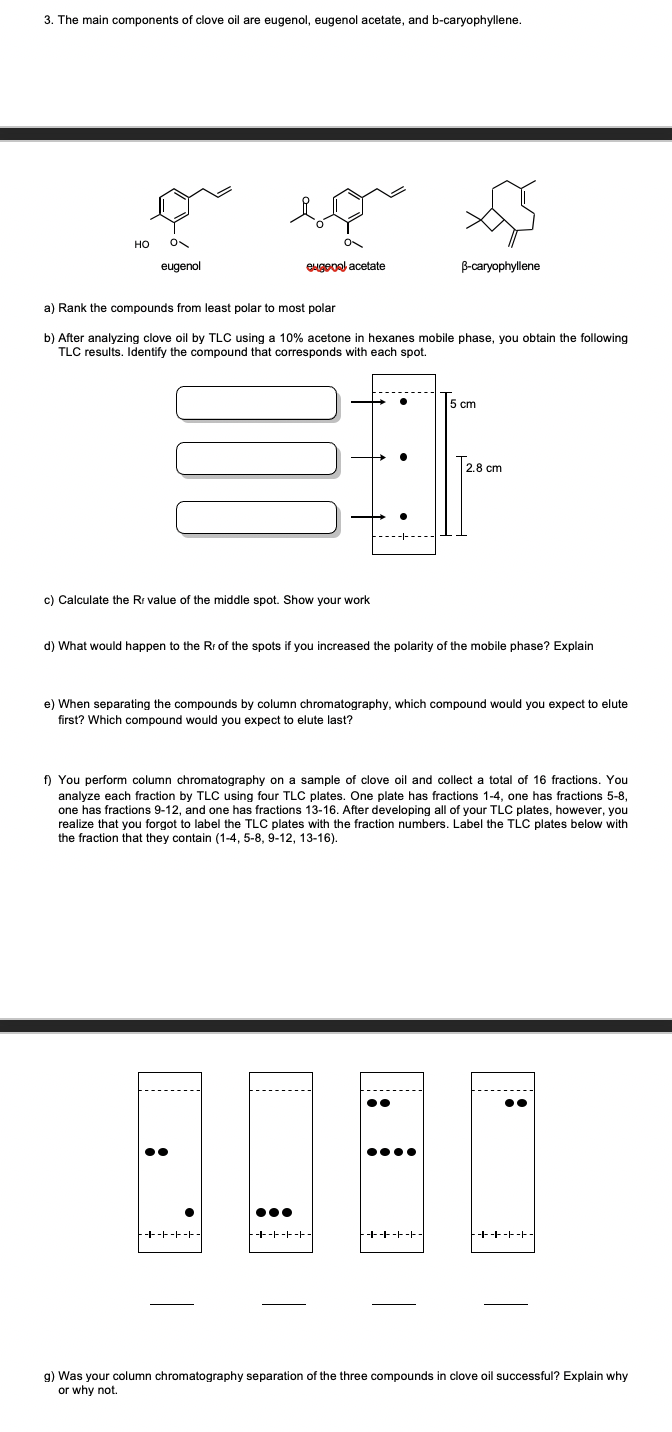Chapter33: High-performance Liquid Chromatography
Section: Chapter Questions
Problem 33.15QAP
Related questions
Question
please answer g

Transcribed Image Text:3. The main components of clove oil are eugenol, eugenol acetate, and b-caryophyllene.
но
eugenol
eugeoal acetate
B-caryophyllene
a) Rank the compounds from least polar to most polar
b) After analyzing clove oil by TLC using a 10% acetone in hexanes mobile phase, you obtain the following
TLC results. Identify the compound that corresponds with each spot.
5 cm
2,8 cm
c) Calculate the Rr value of the middle spot. Show your work
d) What would happen to the Rr of the spots if you increased the polarity of the mobile phase? Explain
e) When separating the compounds by column chromatography, which compound would you expect to elute
first? Which compound would you expect to elute last?
f) You perform column chromatography on a sample of clove oil and collect a total of 16 fractions. You
analyze each fraction by TLC using four TLC plates. One plate has fractions 1-4, one has fractions 5-8,
one has fractions 9-12, and one has fractions 13-16. After developing all of your TLC plates, however, you
realize that you forgot to label the TLC plates with the fraction numbers. Label the TLC plates below with
the fraction that they contain (1-4, 5-8, 9-12, 13-16).
-+-F-F-F-
--+------
++-F-F-
-++-F-F-
g) Was your column chromatography separation of the three compounds in clove oil successful? Explain why
or why not.
Expert Solution
This question has been solved!
Explore an expertly crafted, step-by-step solution for a thorough understanding of key concepts.
This is a popular solution!
Trending now
This is a popular solution!
Step by step
Solved in 3 steps with 3 images

Knowledge Booster
Learn more about
Need a deep-dive on the concept behind this application? Look no further. Learn more about this topic, chemistry and related others by exploring similar questions and additional content below.Recommended textbooks for you


EBK A SMALL SCALE APPROACH TO ORGANIC L
Chemistry
ISBN:
9781305446021
Author:
Lampman
Publisher:
CENGAGE LEARNING - CONSIGNMENT

Principles of Instrumental Analysis
Chemistry
ISBN:
9781305577213
Author:
Douglas A. Skoog, F. James Holler, Stanley R. Crouch
Publisher:
Cengage Learning


EBK A SMALL SCALE APPROACH TO ORGANIC L
Chemistry
ISBN:
9781305446021
Author:
Lampman
Publisher:
CENGAGE LEARNING - CONSIGNMENT

Principles of Instrumental Analysis
Chemistry
ISBN:
9781305577213
Author:
Douglas A. Skoog, F. James Holler, Stanley R. Crouch
Publisher:
Cengage Learning